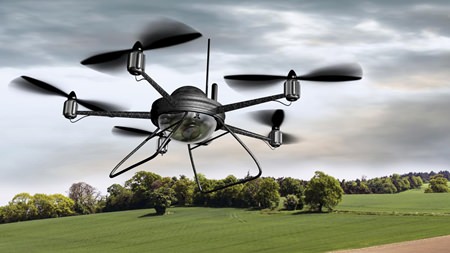I was reminded about helicopters this week when I overheard a young lady saying accusingly to her male partner, “You not butterfly, you helicopter!” To which the quick-witted young man replied, “And you international airport!”
However, in the life of the pro shooter, you sometimes have to face your greatest fears to get the shot that the art director wants. For me that was any height greater than that experienced by standing on a chair. Needing the fee, I took the job.
 Drone aerial shot.
Drone aerial shot.
The brief was simple. I had to shoot a vacant allotment where a hotel and resort was (hopefully) going to be built. The client had the ground and an architect’s model of the proposed resort. My job was to end up with an aerial shot showing the hotel in position, relative to all the other buildings, as if it had been there for some years. Just another example of why you should not believe everything you see.
Technically, shots like these are very difficult, as you have so many factors which have to be taken into consideration, lighting being just one of them. It is a situation that requires a notebook and pen, just as much as a camera.
Working on the principle that we would need some nice warm lighting and good shadow definition, it was decided we would do the aerial shot at 3 p.m. and a helicopter (with doors removed) was booked for 3 p.m. for one hour. Helicopters are not cheap to hire, and since the photographer is paying, I took the one hour minimum.
With all camera gear on board we reviewed the site from the air. I had to decide from what height we needed to do the shooting, and 600 feet seemed the best. We then circled the vacant allotment until the best viewpoint was reached, as we also had to show the beach and some Pacific Ocean, to show the locality of the proposed resort. At the same time we noted the focal length of the lens I would use and did a couple of test Polaroids to settle on the exposure details. The camera, by the way, was a Hasselblad as we had to shoot in medium format, which with its removable backs allowed for Polaroid test exposures.
Then came the first of the problems. It was a windy day and the pilot could not hold the position to allow me to shoot from inside the helicopter and I was going to have to go outside of my little cocoon of safety to get the shot.
This meant wearing a harness with a rope attached and getting out of the helicopter and standing on the landing struts while leaning into the wind and don’t drop the camera! For someone dizzy at one meter above ground level, this was a fearsome task. And did mean I had to trust the photographer’s assistant implicitly.
In around 10 minutes of being buffeted outside the helicopter, I had shot several rolls of film and I was pulled back in and we headed for the airport.
After processing the transparencies, the next part of the job was to shoot the architect’s model in the studio. This meant replicating the lighting direction and the warmth of the light. It also meant shooting from a height in the studio that was the equivalent of 600 feet in the helicopter. This was done by reading the architect’s plans and working out 600 feet relative to the height of the proposed building and then using that formula with the height of the architect’s model. There is several hours involved in just doing that and then more hours in setting up the lights and the camera position.
The following day we began shooting Polaroids, looking at the relativity to the helicopter shots. These were the days long before Photoshop and everything had to be in the correct scale before we would send background and resort model shots to the retouchers.
Only after everything was right did we shoot the transparencies of the architect’s model. In total three days of intense shooting. I earned my money with that shoot.
These days? They just send up a drone. Another nail in the art coffin!




